

Automotive News and Reviews for the Petrolhead
Reuters Motoring Commentator
In this week's issue:
- Ford Focuses on Reworking Lincoln
- Ford Set to Revamp Mustang
After reworking its lower-priced lineup of cars and its foreign luxury flagships, Ford is turning its attention to its Lincoln luxury brand, which has been lost in corporate shuffles and fierce competition from a revived Cadillac.
Ford executives said Lincoln, and its sister brand Mercury, would get 11 new vehicles over the next four years, without spending the billions of dollars that General Motors has poured into reviving Cadillac.
Ford unveiled a trio of concept vehicles for Lincoln. Two of them - the Mark LT pickup based on the Ford F-150 and the Lincoln Aviator car-based sport utility vehicle - are early versions of models that will go into production in 2005.
The third, a convertible based on the Ford Thunderbird called the Mark X, has little chance of production but was meant to show another take on Lincoln's new look, based on the 1961 Continental.
Lincoln's last all-new sedan, the LS, was introduced in 1999 to positive reviews, and the Navigator was the first luxury sport utility vehicle. But as Ford bought Volvo and Land Rover, then created its Premier Automotive Group luxury division, Lincoln lost management attention and funds to other brands.
Its headquarters were moved to California, and many analysts began predicting that Ford would kill Lincoln's sister brand, Mercury, and maybe even Lincoln itself.
"Before we brought the two brands back to Dearborn from their lost weekend in California, these brands weren't working too well," said Jim O'Connor, head of Ford-Lincoln-Mercury sales and marketing. While the Navigator has continued to sell well, a conservative redesign opened the door for the Cadillac Escalade to take its place as the stylish SUV of choice among rap stars and Hollywood elite.
Lincoln tried adding a pickup, but the Blackwood's design, price and lack of options left it dead on arrival. And while the current Explorer-based model of the Aviator hits its sales targets, it has done so at higher-than-expected levels of rebates and discounts, cutting profits.
Lincoln did manage to stop losing sales in 2003, hitting 158,839 in the United States. But all of that growth came from the Navigator and Aviator; all other models saw sales decline. And Mercury sales fell 23 percent, a hard hit for Lincoln dealers, most of whom rely on Mercury vehicles for a majority of their volume.
Ford executives say the key to their plan is boosting Mercury volumes with new models rolling out this year - including the Mariner SUV, the Montego sedan and the Monterey minivan. The Lincoln models will follow in a couple of years, with most derived from Ford models.
While Cadillac's revival was driven in part by edgy styling and a return to rear-wheel-drive cars, Ford executives say future Lincolns will have a more conservative look and won't greatly differ in price from what Lincoln offers today.
"I don't think we need to change the positioning at all," said Phil Martens, Ford's head of North American product development. "I don't want to get into a situation where people think Lincoln should chase something it can't and shouldn't."
Joe Ivers, a partner with automotive research firm J.D. Power and Associates, said Lincoln had fallen off the shopping lists of consumers who now favored German and Japanese luxury vehicles.
"Cadillac has faced a similar existential crisis and clearly established an identity for itself," Ivers said. "Lincolns are still a high appeal vehicle for traditional Lincoln buyers...but both brands have to find a way to make themselves appeal to new generations of affluent people."
Written by Justin Hyde
After four years of neglect, Ford aims to boost its car business with a new flagship sedan and wagon, along with an update of its classic Mustang sports car.
Ford, which could see Toyota soon usurp its place as the world's second-largest automaker, also showed off a small concept SUV that revives the Bronco name, and could go into production as a low-cost entry model.
"We started life as a car company," said Ford Chairman and Chief Executive Bill Ford Jr. "We can't give up on that."
Ford plans to sell about 270,000 Freestyles and Five Hundreds a year once production ramps up from a July launch, with interior space as their main calling card. The Freestyle targets the hot market for car-based sport wagons, promising seating for seven, including a third-row seat that can comfortably handle adults.
The Five Hundred will be billed as Ford's new flagship sedan. While it's about as long as Ford's midsize Taurus, it offers more leg room than nearly all its competitors and a trunk as large as the one in a Lincoln Town Car, able to swallow eight golf bags. Both vehicles were based off Volvo body structures, with a Volvo engineer in charge of development, and designed to get top marks in safety tests. They will be built in Ford's Chicago assembly plant in a new flexible system that lets Ford switch volume easily between models.
On paper, the main drawback for both models is their engine -- a 200-horsepower, 3-litre V6, which has to haul up to 4,100 pounds in an all-wheel-drive Freestyle. Ford has developed a larger, more powerful V6, but it won't reach production until late 2005.
Ford has tried to blunt concerns by offering each vehicle with a six-speed automatic transmission or a high-tech continuously variable transmission that it claims maximizes the engine's power. To demonstrate its case, Ford has given journalists off-the-record test drives of preproduction vehicles, a rare step in Detroit.
But it's a weakness that consumers will note, said George Peterson, president of AutoPacific, an industry analysis company.
"For vehicles of this class and this size, they need larger engines with higher horsepower," Peterson said. "Depending on how they drive and feel, that will really have a lot to do with acceptance."
Peterson also said Ford would have to price the vehicles carefully. Ford executives have said the Five Hundred would compare favourably with a V6-powered Toyota Camry, or around $25,000 (13,900 pounds).
Old Horses, New Tricks
Peterson and other experts say the Mustang is a surer bet. Ford sells more than 130,000 Mustangs a year, and the concept unveiled last year was warmly received by pony car fans for reviving the styling cues from the late 1960s.
The original Mustang used parts from several other Fords to keep its costs low. As Ford switched to front-wheel-drive cars, the Mustang had fewer parts to borrow from, and the current model dates back to a design from 1979, an eternity in the automotive industry.
For the new Mustang, Ford took the basic parts of its Lincoln LS and Jaguar S-Type sedans and made extensive changes to cut costs, such as using a solid rear axle. Ford says it will still offer a V6-powered Mustang for under $20,000, with an optional 300-horsepower V8 available.
The Bronco concept unveiled is a two-door, rugged-looking sport utility based on the Brazilian-built Ford EcoSport. Ford executives have said the EcoSport could be brought to the United States as a competitor to the Chevrolet Aveo, a Korean-made car targeting entry-level buyers.
![]() Ford Focuses on Reworking Lincoln
Ford Focuses on Reworking Lincoln
 "They're obviously are doing what they think is the right thing for them, and I feel pretty good that what we're doing is the right thing for us," said Darryl Hazel, president of Lincoln-Mercury. "Four or five years makes a pretty big difference."
"They're obviously are doing what they think is the right thing for them, and I feel pretty good that what we're doing is the right thing for us," said Darryl Hazel, president of Lincoln-Mercury. "Four or five years makes a pretty big difference."
![]() Ford Set to Revamp Mustang
Ford Set to Revamp Mustang
 Company executives tout the new models -- the 2005 Five Hundred sedan and the Freestyle wagon -- and the updated Mustang as a sign of the blitz of new models Ford is planning over the next few years, part of a plan to stop losses of market share to foreign automakers and boost annual US sales of Ford-branded vehicles by roughly 200,000 to 3 million.
Company executives tout the new models -- the 2005 Five Hundred sedan and the Freestyle wagon -- and the updated Mustang as a sign of the blitz of new models Ford is planning over the next few years, part of a plan to stop losses of market share to foreign automakers and boost annual US sales of Ford-branded vehicles by roughly 200,000 to 3 million.
© 2007 autosport.com . This service is provided under the Atlas F1 terms and conditions.
|
Volume 10, Issue 2
Articles
Massa Transit
Mister Clean
Technical Analysis: Sauber C23
2004 Countdown: Facts & Stats
Columns
The Sauber Trivia Quiz
Rear View Mirror
Bookworm Critique
On the Road
Elsewhere in Racing
> Homepage |